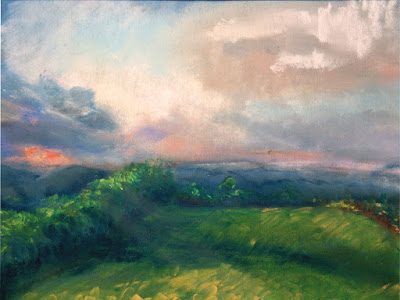Embrace the uncertainty. Don’t panic. Here are some tips.
| Mamaroneck River, Carol L. Douglas. I’m really bad at shooting pictures of my Painters on Location work, but this one is from around 2010. |
On Wednesday, I wrote about the tendency to paralysis when we start producing a body of work we think is awful. I see this among students, but it happens to all of us. Old-timers just recognize it as an unavoidable part of the job and plow through it, miserable as it is.
The dry desert is an inevitable stop along any creative journey. You have three possible paths out:
- Scuttle back to what you were doing before;
- Quit and do something else for a while;
- Find ways to quiet that awful voice in your head.
Obviously, I choose the third path, but the other two are very common (and self-limiting) reactions. Start by reminding yourself of a basic fact: you haven’t suddenly forgotten how to paint. Dissonance is part of growth. Even experiments that fail are valuable; they’re an essential part of the painting process.
|
Beaver Dam on Quebec Brook, available through Gallery of the White Plains County Center through November, 2019. For more information, contact Adam Levi, Rye Art Center, (914) 967-0700.
|
Trusted friends
This morning I’m at Rye Painters on Location. At the first one, I baulked at the starting gate. Daisy de Pothod told me, “You know how to do this!” It snapped me back into reality.
Sometimes friends will suggest changes, but it’s more likely for them to say, “I really like that.” It helps me see past my own skewed judgment.
| Regatta off American Yacht Club, by Carol L. Douglas. This is another painting from Rye of which I didn’t take a very good photo. |
Ask a teacher or fellow professional
You may be wrestling with a technical, rather than emotional, block. Good painting teachers watch your process and redirect you. Identifying the trouble is more than half the battle. But what about the teacher who undermines your confidence? If there’s bad chemistry between you, I simply would not go back.
Painting-a-day disciplines
Painting-a-day programs are helpful at riding through low spots. Your goal isn’t greatness; it’s to finish something every day. In the end, ironically, that’s usually when we do our best work.
There are many of them on the internet, but it’s just as easy to make up your own. I devise all kinds of these for myself and run through them whenever I’m stuck. They’ve taken the form of tree-a-day, still-life-a-day, fantasy-landscape-a-day, and more.
Focus on the process instead of the results
I’ve given you protocols for oilsand watercolor. They’re not the only approach to painting, but they’re good general guides. Focus on them and let the results take care of themselves.
Many people baulk at imposing order on creativity, but it is the basis of every great artist’s practice. And running through the scales is oddly soothing when your soul’s in ferment.
Do exercises that support your weak spots enough that they cease to be weak spots
Are you flummoxed by color? Make color charts or mix matches to paint chips from the hardware. Are you trying to add architecture and people to your paintings but they look awful? Practice drawing. Is your perspective wonky? Find an exercise in perspective and practice until you understand it.



